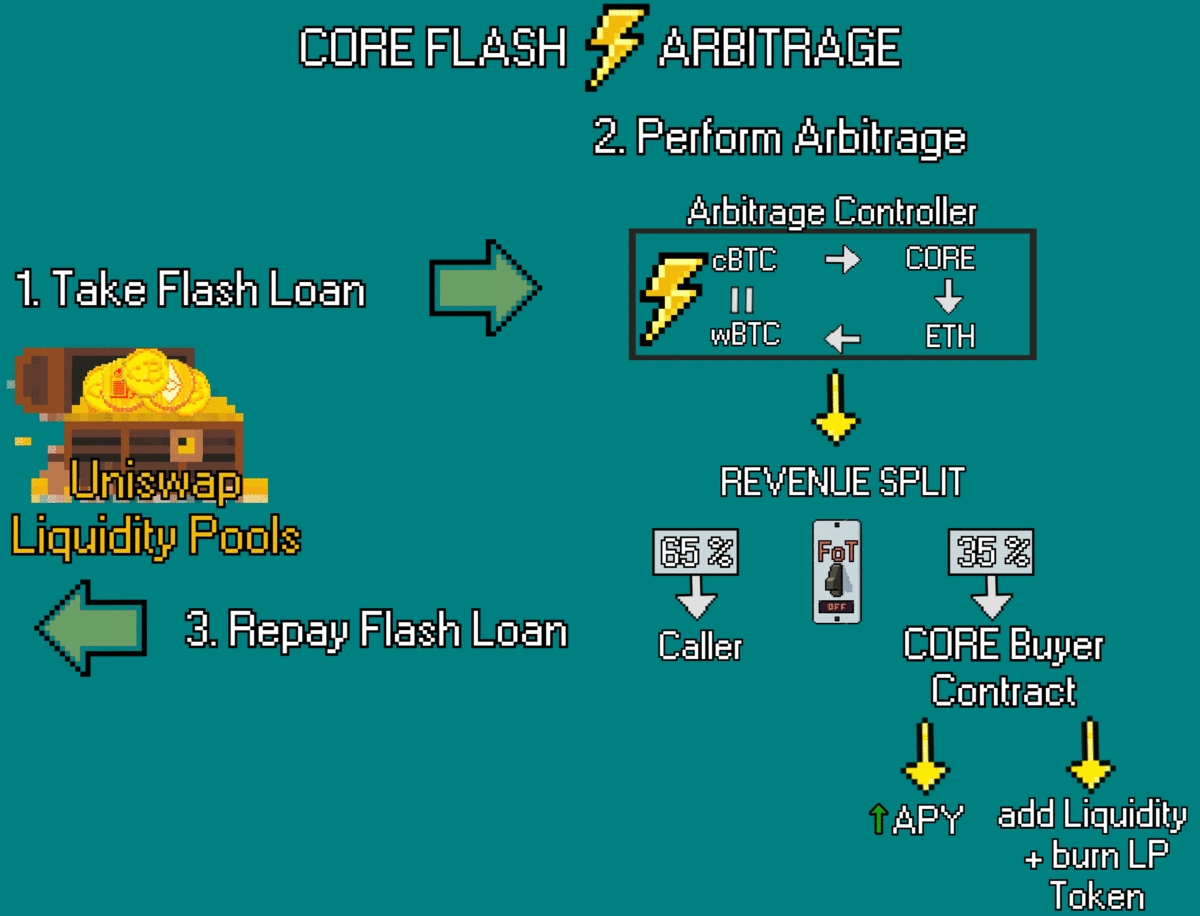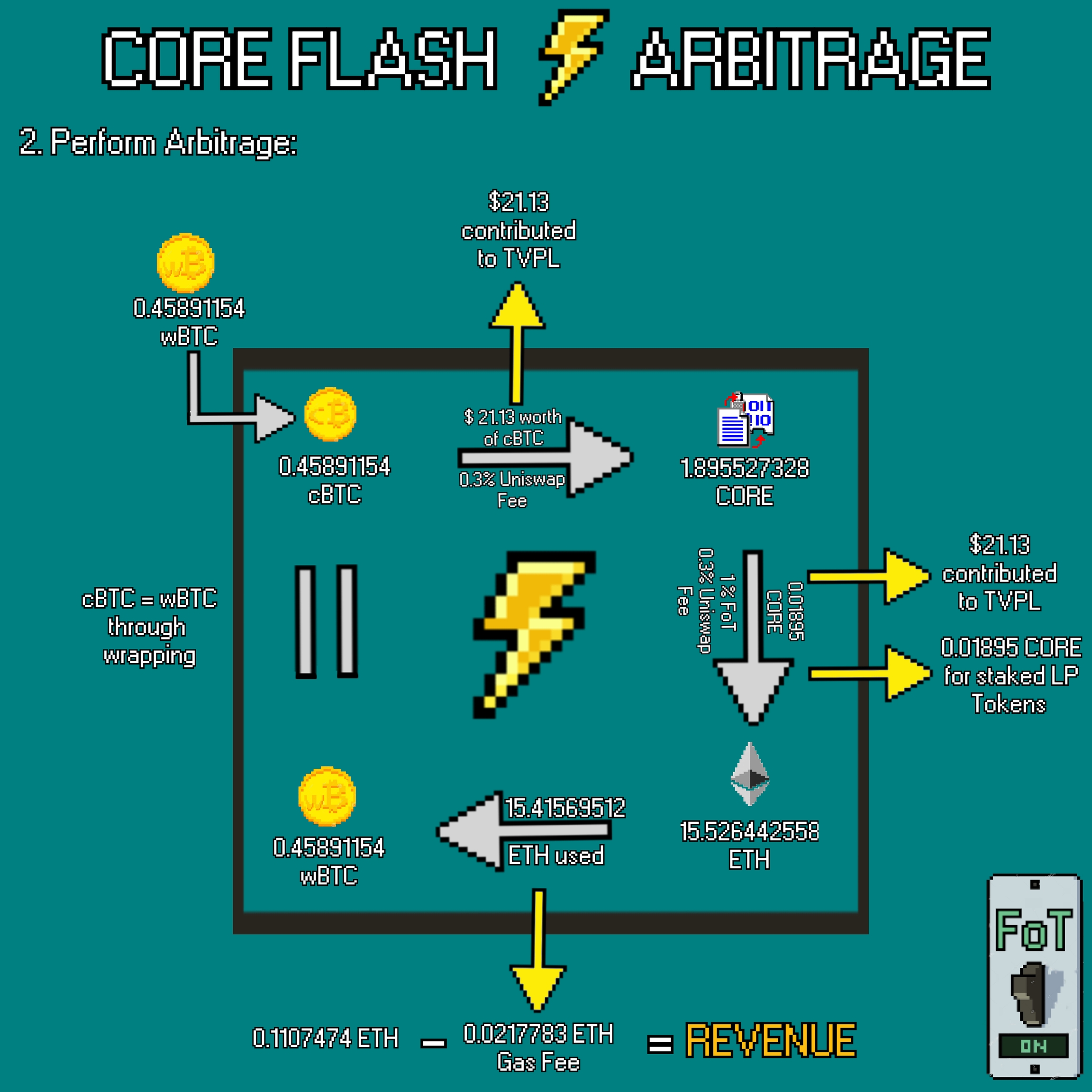CORE Flash Arbitrage
CORE Flash Arbitrage consists of two principals:
Arbitrage
Uniswap Flash Swaps
What is Arbitrage?
Arbitrage represents an opportunity for low risk profit from discrepancies in prices of financial instruments. While Supply and Demand is the primary driving factor behind financial markets, a change in one of these factors can affect the price of an asset. To successfully profit from such an opportunity one must spot the differences in price. In other words, if one and the same product is traded on two markets at different prices, one may profit from arbitrage. In today’s financial markets, traders use automated trading systems that rely on algorithms to spot these discrepancies and profit before the market reacts.
What is a Flash Swap?
The second principal that CORE’s Flash Arbitrage system takes advantage of, are Uniswap Flash Swaps. This feature allows the user to take out a loan from any liquidity pool on Uniswap without any cost, as long as the loan is returned at the end of the transaction. Uniswap allows two ways for this return to happen:
The loan is paid back with the corresponding pool / pair token
The loan is paid back with the original ERC20 token
Example:

You may create a Flash Swap by withdrawing temporarily the liquidity of the wBTC/ETH pool.
In the current example the price of 1 wBTC is 34 ETH.
If you withdraw 1 wBTC as a flash swap from the wBTC/ETH pool, you must end your transaction by either returning 34 Ethereum or 1 wBTC + Uniswap 0.3% fee. If you are unable to meet these ending conditions, the flash swap will fail, and the transaction will get rolled back. If one takes out a Flash Swap and utilizes an arbitrage opportunity before returning the loan, it will generate zero risk profits.
CORE’s Flash Arbitrage ⚡
The Flash Arbitrage is build to bring a powerful and precise tool to the community. The contract uses a specifically crafted algorithm to process a wealth of data and identify opportunities across different pools. CORE’s Flash Arbitrage can be summarized in three steps:

The contract takes a Flash Swap from a pool and performs the arbitrage strategy which was previously selected. The revenue generated through the arbitrage is split between the Caller and the CORE Buyer Contract. The ratio depends on the Fee on Transfer (FoT) function being on or off for the performed strategy. When an arbitrage strategy is performed with FoT on, the max revenue split for the Caller is 10% and 90% for the CORE Buyer Contract. If FoT is turned off, the maximum revenue for the Caller is 65% while the CORE Buyer Contract receives 35%.
The CORE Buyer Contract will add rewards to specific CORE pools to keep them at a designated APY. If all pools reach this threshold, the contract instead adds liquidity to CORE pools and subsequently burns the LP token. The mint and burn of liquidity pool tokens has a compounding effect on the APY of CORE liquidity pools. It increases the liquidity and value of LP tokens while not diluting the APY.
A Closer Look inside an Arbitrage Strategy

The second step of a successful CORE Flash Arbitrage involves selecting a strategy. The image shows a strategy performed on the CORE/cBTC pool while taking a Flash Swap from the wBTC/ETH pool.
Due to the special rules in CORE’s ecosystem a Flash Arbitrage performed on a CORE pool has several positive effects. First of all, every 0.3% Uniswap Fee charged for transactions are directly contributed to the Total Value Permanently Locked (TVPL). In this example it happens between cBTC and CORE and between CORE and Ethereum. Another beneficial effect on the system is the 1% Fee on Transfer which stayed active in this strategy, generating 0.01895 CORE for the CORE/ETH LP token holders.
This Arbitrage strategy performed 3 swaps and one wrap.
0.45891154 wBTC wrapped to 0.45891154 cBTC
0.45891154 cBTC swapped to 1.895527328 CORE
1.895527328 CORE swapped to 15.526442558 ETH
15.41569512 ETH swapped to 0.45891154 wBTC
Due to the price advantage of the three swaps, a surplus of Ethereum was generated, resulting in 0.1107474 ETH being split between the Caller & CORE Buyer Contract.
Last updated
Was this helpful?